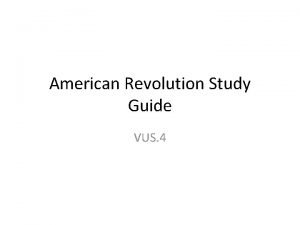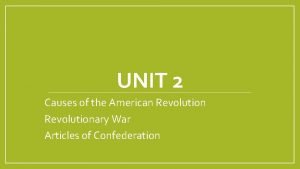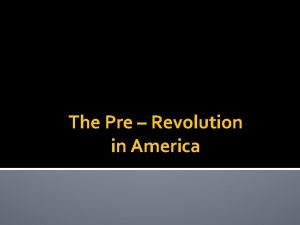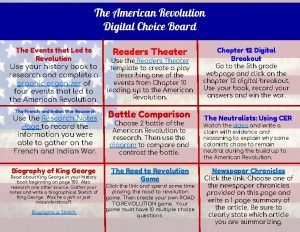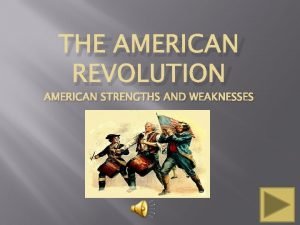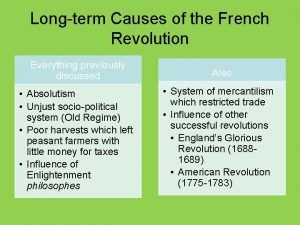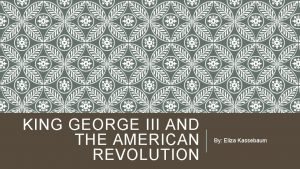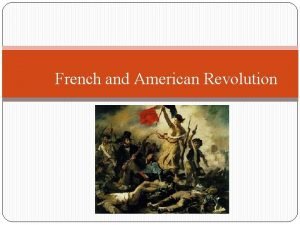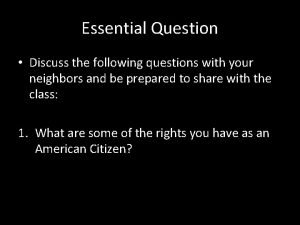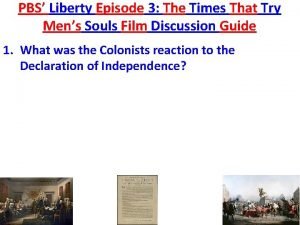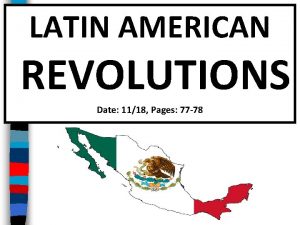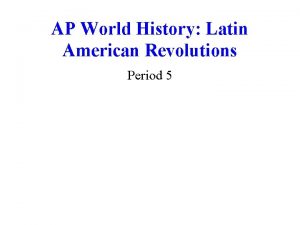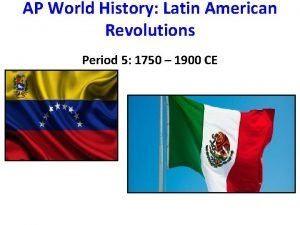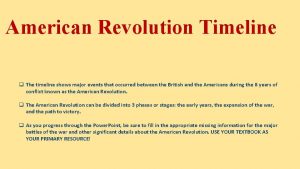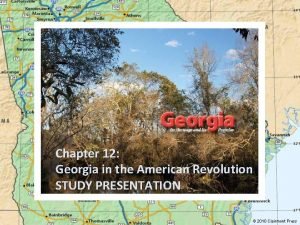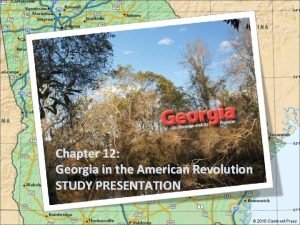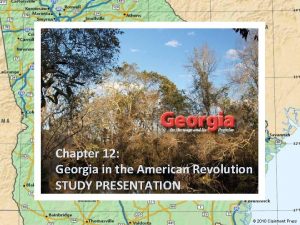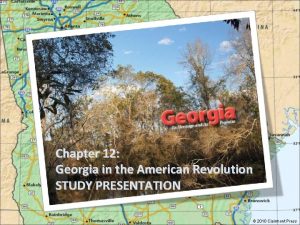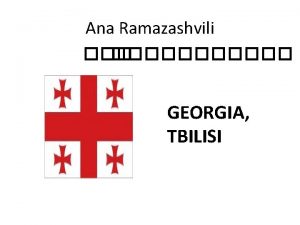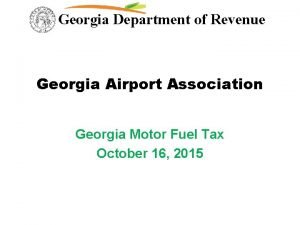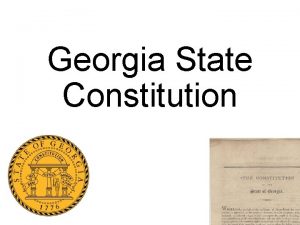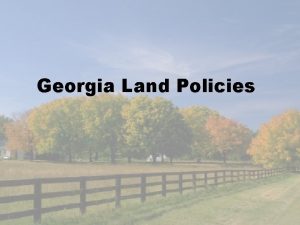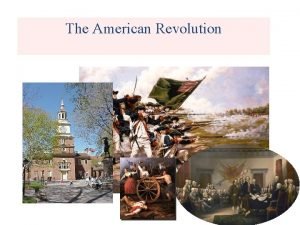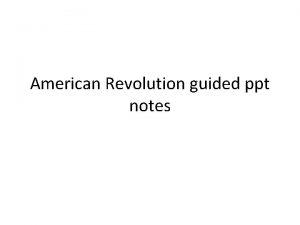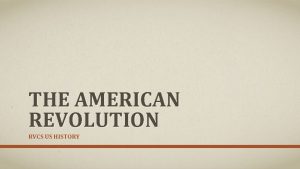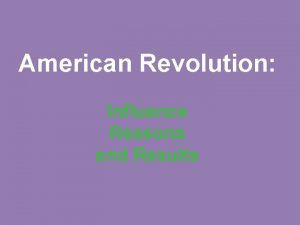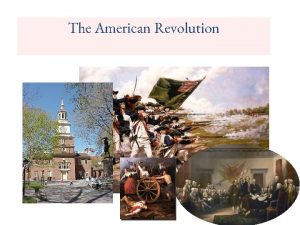Chapter 12 Georgia in the American Revolution STUDY






















- Slides: 22

Chapter 12: Georgia in the American Revolution STUDY PRESENTATION © 2010 Clairmont Press

Section 1: Georgia in the Early Days of the Revolution Section 2: Georgia in the Latter Part of the Revolution

Section 1: Georgia in the Early Days of the Revolution Ø Essential Question: • What was war in Georgia like during the first years of the American Revolution? 3

Section 1: Georgia in the Early Days of the Revolution Ø What terms do I need to know? • • • neutral faction radical conservative siege 4

Section 1: Georgia in the Early Days of the Revolution Ø The war reached Georgia’s coast in January 1776, when British navy vessels arrived at the mouth of the Savannah River. Ø Georgia’s Patriots formed two military groups: Militia (citizen-soldiers) and Continental troops (funded by the Continental Congress). Ø GA had the least amount of Patriot sympathy because: Ø 1. It was a “baby” (young) colony and still depended in England economically 5

Time Line 1775 -1782 6

Battle of the Rice Boats Ø The Battle of the Rice Boats – also called the Battle of Yamacraw Bluff – left Georgia in the hands of the revolutionaries. Ø Governor Wright and his family and other royal officials escaped to the British ships. Ø The British troops successfully captured some boats loaded with rice to ship to their troops in the northern colonies. Ø The Patriots believed they had saved Savannah. 7

Establishing a State Government Ø Georgia revolutionary leaders established a provincial congress in 1776. Ø Patriots controlled the government. Ø Executive branch consisted of Council of Safety and its president. Ø Judicial branch had a court with chief justice and two assistants. Ø From March 1776 (when British troops left Georgia) until British troops returned in December 1778, the revolution in Georgia was basically a civil war fought between Georgia’s Patriots and Loyalists. 8

Native Americans and the War Ø The Indians in Georgia were caught between the warring whites. Ø Loyalist George Galphin tried to keep the Indians neutral (to not take sides in the war). Ø Most traders became loyalists and urged the Indians to fight with the British. Ø The Patriots did not have many presents to give the Indians, and most Indians who fought sided with the British and the loyalist traders. 9

Florida and the War in Georgia Ø Colonel Lachlan Mc. Intosh commanded the Georgia battalion of the Continental Army. Ø He took responsibility for Savannah’s defense and later led an unsuccessful invasion of British Florida. Ø Florida Rangers, loyal to the British, staged several raids into south Georgia. Ø Mc. Intosh was part of a faction (group) from the Savannah area that wanted independence and to limit who could serve in government. Ø Another faction, which wrote the state’s new constitution, wanted ordinary people to have more say in a government independent from Great Britain. Button Gwinnett belonged to this group. 10

GA Constitution of 1777 Ø Georgia reorganized its government and its 12 colonial parishes became eight counties. Ø The counties took over the work of local government. Ø A new state constitution in 1777 helped GA transition from a colony to a state Ø Radical Patriots (those who wanted the most change) supported this constitution and its democratic language. Ø Conservatives (those who wanted less change) thought the constitution made too many “ordinary” men eligible to vote and hold office. Ø Georgia’s governor had limited power and could only serve a single one-year term. Leg. Branch most powerful 11

Original Georgia Counties 1777 12

Section 2: Georgia in the Latter Part of the Revolution Ø Essential Question • What was Georgia’s role during the latter part of the American Revolution? 13

Section 2: Georgia in the Latter Part of the Revolution Ø What term do I need to know? • siege 14

Another Invasion of Florida Ø John Houstoun, Georgia’s second governor, helped lead an expedition to Florida. Ø The Florida Rangers retreated from the border. Ø Instead of moving deeper into Florida, the Continental troops and the Georgia militia returned to Georgia and toward Savannah. Ø There was much disagreement among the militia and the Continental troops over who was in charge. Ø These leadership quarrels made Georgia’s Florida invasions unsuccessful. 15

The Fall of Savannah, Sunbury, and Augusta Ø Sir Henry Clinton chose Savannah as the first target for Great Britain's southern invasion of 1778. Ø The British easily captured Savannah in December 1778. Ø The Georgia Patriot government fled. Ø The British offered to pardon all Patriots who would take an oath of allegiance to the King. Ø By January 31, Augusta (north of Savannah) and Sunbury (south of Savannah) were under British control. 16

The Battle at Kettle and Brier Creeks Ø On February 14, 1779, rebel forces surprised a Loyalist camp led by Colonel James Boyd at Kettle Creek, northwest of Augusta. Ø Patriot militia led by Andrew Pickens, John Dooly, and Elijah Clarke surrounded the Loyalist camp. Ø Austin Dabney, a slave, was wounded and later honored for “bravery and fortitude. ” Ø Kettle Creek won the militia much needed supplies and lifted their morale. Proved that there were more Patriots than was originally thought in GA. Ø The Battle of Brier Creek, less than a month later, was a major Patriot defeat. Ø The British reestablished a royal government in Savannah. Elijah Clark Link: Austin Dabney’s land grant. 17

The Siege of Savannah Ø The French arrived with 22 ships and 4, 000 troops in September 1779 to liberate Savannah. Ø French Commander Count D'Estaing demanded Savannah’s surrender, but British General Augustine Prevost delayed and then refortified his defenses. Ø The French began a three-week siege of Savannah. They surrounded and bombarded the city. They tried to prevent supplies from reaching it. Ø By the end of October, the French were gone and the British and Loyalists in Savannah celebrated their victory. Ø The Battle of Savannah was the bloodiest single hour of the Revolution. Ø By May 1780, both Savannah and Charleston, the South’s two major ports, were in British hands. 18

The War in the Backcountry Ø Georgia’s backcountry was the target of the British in Georgia and South Carolina. Ø Bands of Patriots and Loyalists roamed the backcountry, raiding homes. Families were sometimes murdered and crops burned. Ø The stories of Nancy Hart center on a Patriot wife and mother who became legendary in defense of her home against a group of Loyalists. She shot 2 Tories (Loyalists), killing 1, who entered her house. She stole their guns and held them at gunpoint. The rest were hanged. Link: Nancy Hart 19

The Battles for Augusta Ø The British had control of Augusta after the First Battle of Augusta. They strengthened the city’s defenses. Ø Continental Army General Nathanael Greene chose Lieutenant Colonel “Lighthorse Harry” Lee to retake Augusta. Ø Working with Lee, Colonel Elijah Clarke of Georgia and General Andrew Pickens of South Carolina captured British supplies. Ø The Patriots had regained control of Augusta by June 1781 and the Patriot government returned. 20

The End of the War in Georgia ØIn October 1781, British General Cornwallis surrendered his entire army at Yorktown, Virginia. ØSavannah was still in British control, but in May 1782, the royal government in Georgia was ordered to evacuate. ØIn July 1781, British troops and government officials, and hundreds of loyalists, left in ships. Some went to East Florida, hoping to get land there and start over. ØThe Georgia Patriot government relocated to Savannah and began the process of governing. 21

Return to Main Menu 22
 Did american revolution cause french revolution
Did american revolution cause french revolution Road to revolution study guide answer key
Road to revolution study guide answer key The american revolution chapter 6 section 4
The american revolution chapter 6 section 4 Chapter 6 section 4
Chapter 6 section 4 Russian revolution vs french revolution
Russian revolution vs french revolution Third agricultural revolution definition
Third agricultural revolution definition 10 causes of the american revolution
10 causes of the american revolution Peter zenger american revolution
Peter zenger american revolution American revolution facts
American revolution facts American revolution diorama
American revolution diorama American revolution choice board
American revolution choice board Causes and effects of american revolution
Causes and effects of american revolution Wentworth cheswell
Wentworth cheswell American revolution causes and effects
American revolution causes and effects Who was the king during the american revolution
Who was the king during the american revolution Effects of american revolution
Effects of american revolution American french revolution venn diagram
American french revolution venn diagram Liberty the american revolution episode 3
Liberty the american revolution episode 3 Latin american revolutions date
Latin american revolutions date American revolution jeopardy
American revolution jeopardy Jose de san martin ap world history
Jose de san martin ap world history Latin american revolution definition ap world history
Latin american revolution definition ap world history Road to american revolution timeline
Road to american revolution timeline

